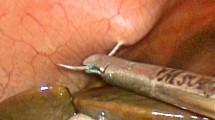Abstract
Cholangiography is often crucial for establishing the definitive cause of neonatal jaundice. We present our protocol for using laparoscopy-assisted cholangiography in infants with prolonged jaundice and discuss its benefits. Firstly, a 5 mm supra-umbilical trocar is introduced to create a port for a 0° laparoscope. A 5 mm trocar is then inserted through a right subcostal incision to allow the liver and gallbladder to be visualized. If the gallbladder is of good size, the fundus is exteriorized through the right subcostal trocar site and a catheter is inserted into the gallbladder for cholangiography. If the gallbladder is atretic, the fundus is not exteriorized and a laparotomy is performed for open intraoperative cholangiography because the lumen of an atretic gallbladder is usually not fully patent and cholangiography through its exteriorized fundus often fails. We reviewed 18 jaundiced infants thought to have biliary atresia (BA) who had laparoscopy-assisted cholangiography. At laparoscopy, four patients had good sized gallbladders and minimal to mild liver fibrosis. They underwent cholangiography via the exteriorized fundus, and BA in two cases and biliary hypoplasia in two cases were identified. The remaining 14 had atretic gallbladders and varying degrees of liver fibrosis. Cholangiography via the exteriorized fundus was performed in one patient, but failed and converted to open cholangiography. Open intraoperative cholangiography identified BA in all 14 cases. All BA cases progressed to Kasai portoenterostomy directly after diagnosis. Laparoscopy is used to determine the type of cholangiography to be performed based on the appearance of the gallbladder and this simple, accurate, and safe protocol allows the anatomical structure of the biliary tree to be obtained accurately with minimal surgical intervention.


Similar content being viewed by others
References
Meyers RL, Book LS, O’Gorman MA, White KW, Jaffe RB, Feola PG, Hedlund GL (2004) Percutaneous cholecysto-cholangiography in the diagnosis of obstructive jaundice in infants. J Pediatr Surg 39:16–19
Hirsig J, Rickham PP (1980) Early differential diagnosis between neonatal hepatitis and biliary atresia. J Pediatr Surg 15:13–15
Karrer FM, Lilly JR, Stewart BA, Hall RJ (1990) Biliary atresia registry, 1976–1989. J Pediatr Surg 25:1076–1081
Greene HL, Helinek GL, O’Neil J (1979) A diagnostic approach to prolonged obstructive jaundice by 24 h collection of duodenal fluid. J Pediatr 95:412–414
Ikeda S, Sera Y, Akagi M (1989) Serial ultrasound examination to differentiate biliary atresia from neonatal hepatitis—special reference to changes in size of the gallbladder. Eur J Pediatr 148:396–400
Kirks DR, Coleman RE, Filston HC, Rosenberg ER, Merten DF (1984) An imaging approach to persistent neonatal jaundice. ARJ 142:461–465
Ohnuma N, Takahashi T, Tanabe M (1997) The role of ERCP in biliary atresia. Gastrointest Endosc 45:365–370
Yamamoto H, Yoshida M, Ikeda S, Terakura H, Sera Y (1994) Laparoscopic cholecystcholangiography in a patient with biliary atresia. Surg Laparosc Endosc 4:370–372
Hay SA, Soliman HE, Sherif HM, Abdelrahmen AH, Kabesh AA, Hamza AF (2000) Neonatal jaundice: the role of laparoscopy. J Pediatr Surg 35:1706–1709
Shah AA, Sitapara AM, Shah AV (2002) Laparoscopy in diagnosis of prolonged neonatal jaundice. Indian Pediatr 39:1138–1142
Hasson HM (1971) A modified instrument and method for laparoscopy. Am J Obstet Gynecol 110:886–887
Senyuz OF, Yesildag E, Emir H, Tekant G, Bozkurt P, Serimurat N, Soylet Y (2001) Diagnostic laparoscopy in prolonged jaundice. J Pediatr Surg 36:463–465
Okazaki T, Kobayashi H, Yamataka A, Lane GJ, Miyano T (1999) Long-term postsurgical outcome of biliary atresia. J Pediatr Surg 34:312–315
Kobayashi H, Yamataka A, Koga H, Okazaki T, Tamura T, Urao M, Yanai T, Lane GJ, Miyano T (2005) Optimum predonisolone usage in patients with biliary atresia post- portoenterostomy. J Pediatr Surg 40:327–330
Author information
Authors and Affiliations
Corresponding author
Rights and permissions
About this article
Cite this article
Okazaki, T., Miyano, G., Yamataka, A. et al. Diagnostic laparoscopy-assisted cholangiography in infants with prolonged jaundice. Ped Surgery Int 22, 140–143 (2006). https://doi.org/10.1007/s00383-005-1609-0
Accepted:
Published:
Issue Date:
DOI: https://doi.org/10.1007/s00383-005-1609-0




